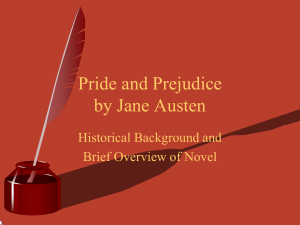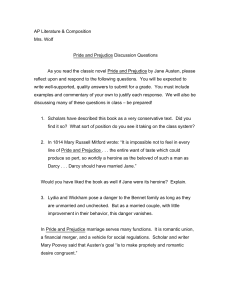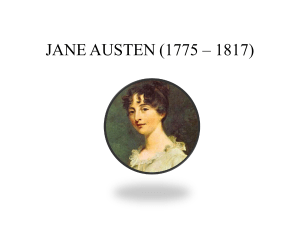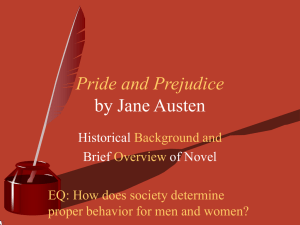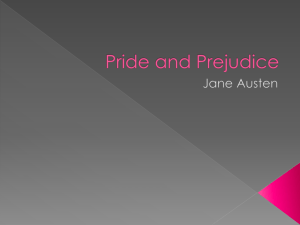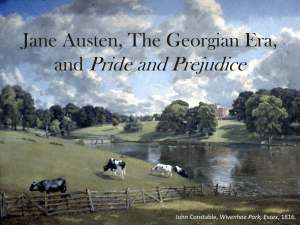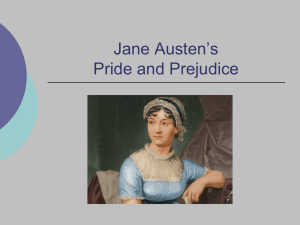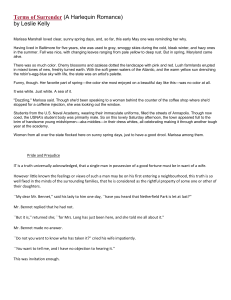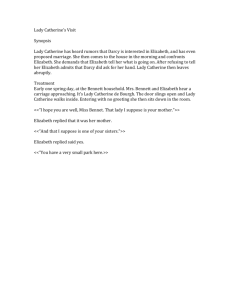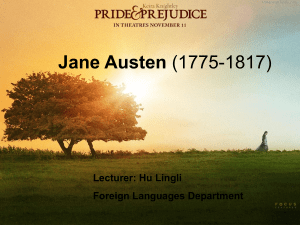eng301paper3
advertisement
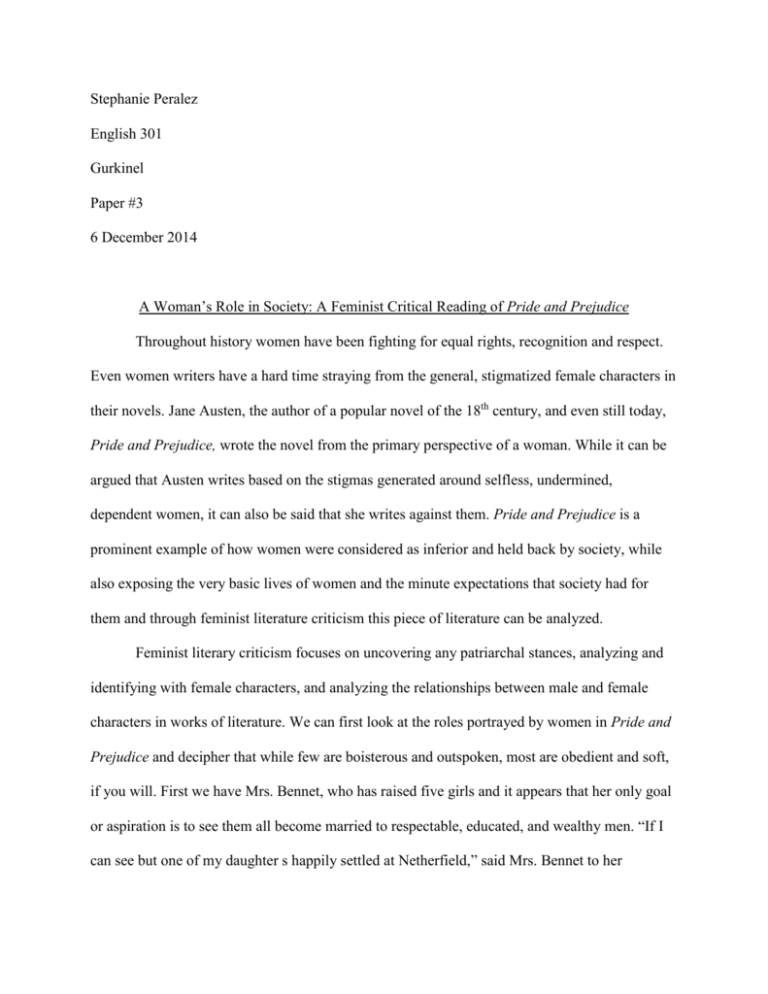
Stephanie Peralez English 301 Gurkinel Paper #3 6 December 2014 A Woman’s Role in Society: A Feminist Critical Reading of Pride and Prejudice Throughout history women have been fighting for equal rights, recognition and respect. Even women writers have a hard time straying from the general, stigmatized female characters in their novels. Jane Austen, the author of a popular novel of the 18th century, and even still today, Pride and Prejudice, wrote the novel from the primary perspective of a woman. While it can be argued that Austen writes based on the stigmas generated around selfless, undermined, dependent women, it can also be said that she writes against them. Pride and Prejudice is a prominent example of how women were considered as inferior and held back by society, while also exposing the very basic lives of women and the minute expectations that society had for them and through feminist literature criticism this piece of literature can be analyzed. Feminist literary criticism focuses on uncovering any patriarchal stances, analyzing and identifying with female characters, and analyzing the relationships between male and female characters in works of literature. We can first look at the roles portrayed by women in Pride and Prejudice and decipher that while few are boisterous and outspoken, most are obedient and soft, if you will. First we have Mrs. Bennet, who has raised five girls and it appears that her only goal or aspiration is to see them all become married to respectable, educated, and wealthy men. “If I can see but one of my daughter s happily settled at Netherfield,” said Mrs. Bennet to her 2 husband, “and all the others equally well married, I shall have nothing to wish for” (Austen 15). While it is not unusual for parents to want the best for their children, this happens to be Mrs. Bennet’s only hobby and therefor brings cause for concern. In today’s society, there is a push for women to strive for more; education, career, and an individual social status. Without proper attribute or acceptance into society in regards to education and career, women were subject to rely solely on raising their children to be acceptable to the public. Next we have Miss Bingley, a sophisticated and harsh young lady who although has the means through family fortune and formal education, is introduced in the novel as the sister to Mr. Bingley and will be staying with him to keep house. Even through her many accomplishments and connections through prominent and esteemed members of society, Miss Bingley is reliant on her brother for social gatherings and introductions. During a discussion at Netherfield Park Miss Bingley expresses what it means to her to be an accomplished woman: No one can really be esteemed accomplished who does not greatly surpass what is usually met with. A woman must have a thorough knowledge of music, singing, drawing, dancing, and the modern languages, to deserve the word; and besides all this, she must possess a certain something in her air and manner of walking, the tone of her voice, her address and expressions, or the word will be but halfdeserved. (Austen 50) In A Feminist Perspective by Johanna M. Smith, she states that, “The myth of perfectibility is central to the politics of Mary Shelley’s parents, and while she was skeptical of such optimism her work throughout is deeply engaged with the problematic of education” (Smith 318). To be such an accomplished woman meant that you were the epitome of perfection and both Mr. Darcy and Elizabeth Bennet express the rarity in knowing such women. Women in the time of Pride 3 and Prejudice were not entitled to institutional education and to be so accomplished in many arts meant that she came from a wealthy family and even then, it did not mean she was to spend her time doing such things. These women were to stay home, rear children, and entertain guests as they chose to stop by and these were the types of traits men looked for in a woman that he desired to make his wife. “The arts of pleasing men, in other words, are not only angelic characteristics, in more worldly terms, they are proper acts of a lady. (Gilbert and Gubar 816)” In Austen’s novel, it is hard to say that any of the women show any of these angelic features and that in fact may be what she was striving for. That none of the characters fit the mold of the perfect, pleasing housewife may have been the job at society that Austen was trying to make in the name of feminism. Mrs. Bennet is noisy, desperate, and tiresome and Elizabeth Bennet is prideful, stubborn, and outspoken. The closest angelic figures in the novel are Jane Bennet for being gentle, reserved, and good spirited even while heart broken and Charlotte Lucas for being agreeable, modest, and practical although she seems to be simple and a bore. According to Gilbert and Gubar, “assertiveness, agreesiveness—all characteristics of a male life of ‘significant action’ – are ‘monstrous’ in women precisely because ‘unfeminine’ and therefore unsuited to a gentle life of ‘’contemplative purity’” (819). These are traits given to Lady Catherine de Bourgh who is bossy, snobby, and overbearing. Lady Catherine de Bourgh as a tall, large woman, with strongly-marked features, which might once have been handsome. Her air was not conciliating, nor was her manner of receiving them such as to make her visitors forget their inferior rank. She was not rendered formidable by silence’ but whatever she said was spoken in so authoritative a tone, as marked her self-importance… (Austen 188) 4 While men were able to hunt, work, go to institutions, hold balls, and marry who they choose, women were far less fortunate. Men throughout the novel are shown with far more independence and privacy than any women. Mr. Bennet himself is rarely seen outside of his personal study and other men throughout the novel are rarely seen in their private or intimate settings. In such circumstances, these men were also never confronted about their privacy or the time they spent with other men. However, women were not as inclined to such privacy or intimate lives. Elizabeth Bennet turned down not one, but two marriage proposals as she vowed to only marry for love and not for the sake of wealth or convenience. While her reasoning may seem fitting for those of us in the twenty first century, it was not so in the time of Pride and Prejudice. Not only does Elizabeth break tradition by declining potentially successful marriage proprosals to both Mr. Collins and Mr. Darcy, she is then insulted by Lady Catherine du Bourgh, a member of her own gender, for not being qualified to marry the latter of the two men. “You will be censured, slighted, and despised, by everyone connected with him…They (Mr.Darcy and Miss de Bourgh) are destined for each other by the voice of every member of their respective houses; and what is to divide them? The upstart pretensions of a young woman without family, connections, or fortune” (395). Through all the turmoil and distress Elizabeth has caused, she does not back down. Lady de Bourgh is very harsh on her own sex and even down right cruel to suggest that due to her social standing and family relations that Elizabeth is not worthy of her nephew. I believe that this was Austen’s jab at society. Not only is she using such a controversial scene to portray the inequalities of being able to accept a marriage proposal but the downright ridiculousness of social standings or good breeding being the sole purpose of getting married. 5 “A life of feminine submission, of ‘contemplative purity,’ is a life of silence, a life that has no pen and no story, while a life of female rebellion, or ‘significant action,’ is a life that must be silenced, a life who monstrous pen tells a horrible story” (Gilbert and Gubar 824). Elizabeth Bennet, our pivotal character throughout the analysis holds a high standard of decision making and following one’s heart, which are both traits unknown to women at that particular time period. While eventually Elizabeth does become a housewife, she becomes a housewife for love, for her values, and against society’s intentions. While Jane Austen nearly plays into the stigmas of lowly, non-opinionated, obedient women, she actually plays against them by mocking and even breaking the standards. With Lady Catherine du Bourgh we see a woman in society who is held in high regards to her fellow patrons but displays masculine-like traits and Mrs. Bennett who is a typical housewife but is outspoken and regarded as annoying and embarrassing. Then there is Miss Elizabeth Bennet who decides to marry for herself and not for her family and defies a large number of social standards by speaking her mind, refusing marriage, and breaking the societal standards. 6 Works Cited Austen, Jane. Pride and Prejudice. The Project Gutenberg. 2008. eBook. Gilbert, Sandra and Susan Gubar. “The Madwoman in the Attic.” Literary Theory: An Anthology. Ed. Julie Rivkin and Michael Ryan. Malden: Blackwell Publishing, 2004.418 430. Print. Smith, Johanna M.. “A Feminist Perspective.” Mary Shelley, Frankenstein. Ed. J.Paul Hunter. New York, NY: W.W. Norton & Co., 1995. 313-333. Print.
